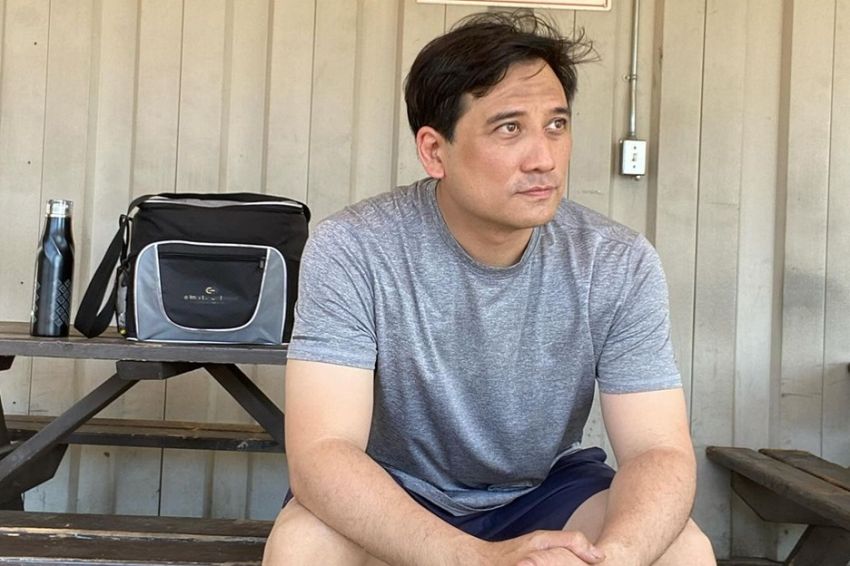In his career as a filmmaker, Alex Garland has terrified us with zombies, infectious alien hybrids, murderous men And The AI is going crazy. Civil warthe latest film from the writer and director, is not only his most ambitious entry but also his most plausible.
Press notes for Civil war describe the setting as “near-future America,” but it feels like it could be tomorrow.
This is not a struggle taking place in a distant country. This is happening in America. In the parking lot of a blackened JCPenney. In the streets of the capital riddled with bullets and barricades.
Garland sets the tone early on when we meet Kirsten Dunst as Lee, a combat photographer surprised to be covering a war at home.
With Nick Offerman as President of the United States for his third term, the country disintegrated into factions – the Florida Alliance uniting with the Western Alliance (Texas and California), all pushing toward the White House.
Although the whole idea of blue-state Californians and red-state Texans working together may sound like science fiction, Civil war imagines a scenario in which a president refuses to leave office, seemingly forcing states to overcome their political differences.
WATCH | The official Civil War trailer:
The obscure origins of the war
Squinty and eagle eyes can catch a card, just a simple reflection of a television, showing the states that came before. The lack of clarity on the origins of the war is a feature, not a bug.
Garland is much less interested in some political science thought experiments than in exploring what war is like. (See this one on the biggest, loudest screen you can find.)
It’s these shocking images – the UN relief camp in the abandoned stadium and the deafening noise of helicopters flying over the capital – that make this near-future scenario feel like the present.
Ask Garland how difficult it was to find these scenes of decay and abandonment and his answer is: “Not very difficult at all.” The abandoned football stadium and the graffiti are still there. All they did was add the tents.
Speaking to CBC News, Garland said: “The West can seem so rich… but the wealth is concentrated. There are areas of truly extreme poverty in America. »
In the divide between the haves and the have-nots, polarization flourishes. Civil war explores what happens when the common fabric that holds a country together is torn apart.
A road trip with journalists
Garland’s father was a political cartoonist, and he grew up with journalists and foreign correspondents as close family friends. Thus, for the director, journalism is a vaccine against creeping disintegration.
So it’s no surprise that it’s Lee and the group of journalists he joins who propel the story. Wagner Moura (whom you may recognize from Narcos) is excellent as the seemingly enthusiastic newspaper reporter Joel.
He and Lee plan to travel to Washington to interview the president before the fall of the White House.
Civil war Rounding out the cast are Cailee Spaeny as Jessie, an aspiring photographer who embarks on the journey, and Stephen McKinley Henderson as Sammy, an older scribe who works for “what’s left of the New York Times.”
WATCH | An excerpt from Civil War:
Although the trope of saddling Lee with wide-eyed Jessie is familiar, the contrast between the two highlights how Dunst fully becomes his character.
I wonder if British filmmakers appreciate the power of seeing Dunst, the brilliant face that so many grew up watching bring it And Spider Mannow carrying this tangible weariness of the world.
Dunst replicates the same look you see on soldiers or first responders. When there is an explosion, she runs towards the carnage. What does that do to a person? Dunst shows us.
It’s not a party
The fact that Civil war essentially functions as a journalist-led road movie and may surprise those who expect it. Roland Emmerichwidescreen style carnage. But what makes Civil war so powerful is that it’s the opposite – a visceral and intimate look, to quote the Talking Heads, Life during war.
One of Garland’s most effective techniques is contrasting moments of beauty with chaos.
After a long day on the road, journalists camp around their vans watching bullet tracers light up the night sky.
Garland breaks the reverie with a hard blow, throwing us into a firefight, Lee’s aim just a few feet from the soldiers returning fire.

A post-modern playlist
To further complete the chaos, Civil war adds a few drops of choice needles.
No more old gold Apocalypse now And Good morning Vietnam, replaced by incongruous but undeniably funky hip-hop jams and tremulous post-punk melodies. The sound injections accentuate the absurdity, emphasizing the way in which the shocked journalists try to compartmentalize what they have witnessed.
Initially, the four reporters fit perfectly into archetypes. Lee, the world-weary vet. Joel, the adrenaline junkie. Sammy, the cautious eldest, and Jessie, the hero-worshipping youngster.
Although there are moments that push the boundaries of belief (Jessie brings chemicals on hand to develop her photos on the road), as the group approaches their goal, the hull The hardened shield that journalists use to protect themselves is beginning to crack and distinctions are fading.
Alex Garland tells CBC’s Eli Glasner how Jesse Plemons came to star in his new dystopian epic Civil War.
For much of the film, Garland walks a fine line, trying to make a film about war without glamorizing it.
“Movies always want to seduce,” Garland told CBC News. “It’s very powerful, so you guard against it.”
The result is a film not so much about war as about its effects.
Civil war captures a very 21st century feeling of helplessness. War is not hell, it simply is. The reasons, the causes, none of it matters – it’s just another thing to endure.
At one point, the reporters encounter two soldiers during a sniper shootout. When Joel tries to find out who they’re fighting, the weary soldier responds, “Someone’s trying to kill us.” We are trying to kill him.


“Internet fanatic. Evil organizer. Tv fanatic. Explorer. Hipster-friendly social media junkie. Certified food expert.”




:strip_icc():format(jpeg)/kly-media-production/medias/2579310/original/039167700_1546583310-kanada.jpg)
:strip_icc():format(jpeg)/kly-media-production/medias/4889148/original/004013400_1720683504-firman_1.jpg)

